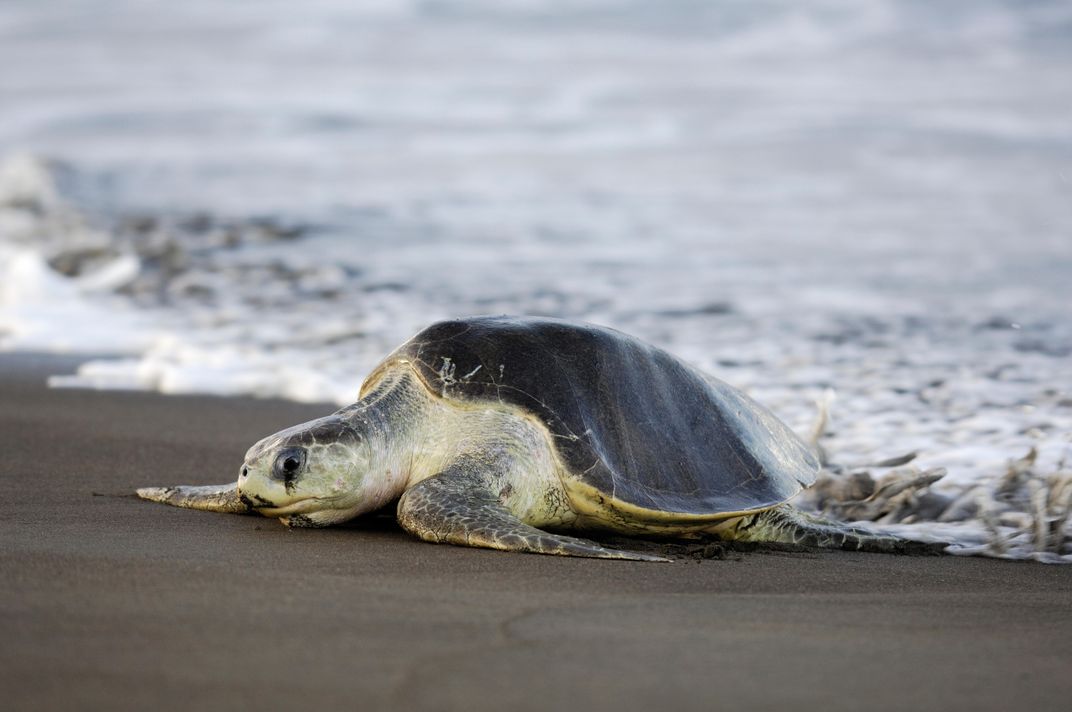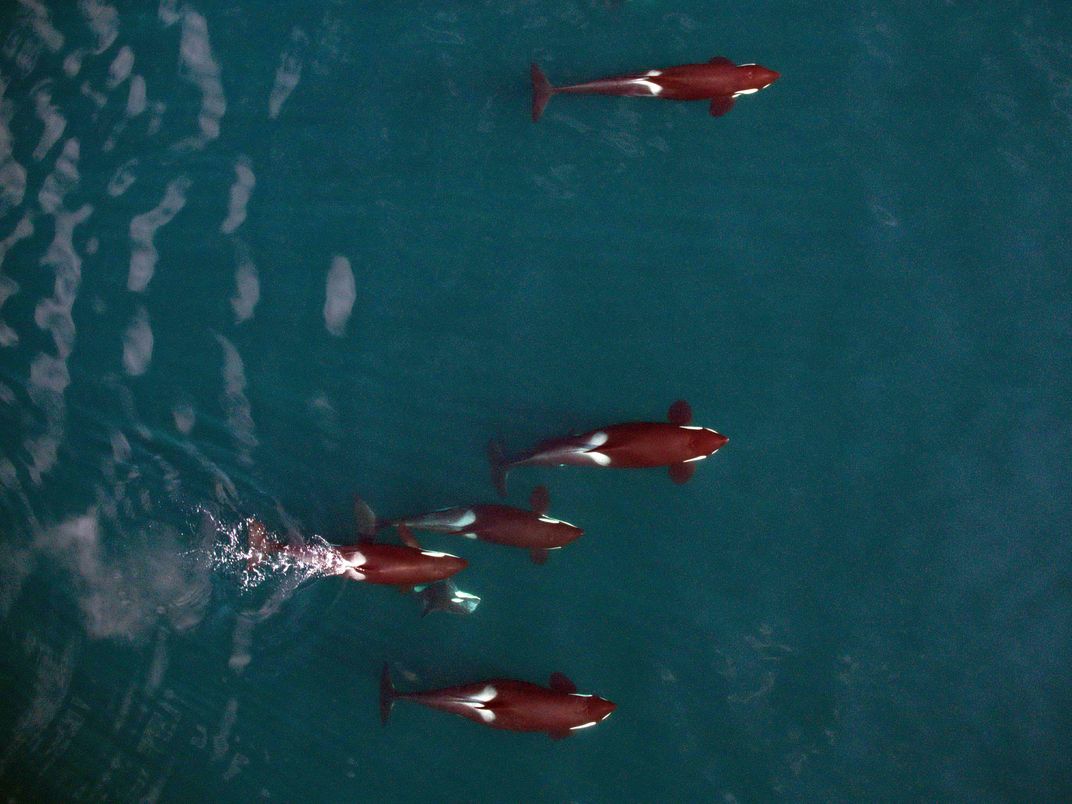How Drones in the Sky Unlock Secrets of the Sea
Researchers are using aerial technology to track coastal erosion, map coral reefs and even give whales a breathalyzer
/https://tf-cmsv2-smithsonianmag-media.s3.amazonaws.com/filer/cf/21/cf21caf8-bc83-4066-a48a-ae6065e7b2a2/nrkw_from_above02.jpg)
In August 2015, a group of ocean researchers gathered on the coast of Costa Rica to study the nesting behavior of the rare Olive Ridley sea turtle. The scientists wanted to find out the turtles’ mysterious behavior offshore—an unknown even to experts on the reptiles' annual migration, known as the arribada. To do so, they turned to unlikely research tool: drones. Far above them, a senseFly eBee fixed wing glider surveyed the scene.
Using the glider, researchers were able to observe the turtles congregating offshore in clusters before making their way to the beach to nest, a discovery that raised new behavioral questions. But after five flights, drones specialist Rett Newton of Duke University noticed something strange. The sand from the beach was clinging to the metallic pieces of the aircraft. More alarming, a strange noise was emitting from the engine.
“As we started to run the motor we started to hear some crunchy type sounds,” says Newton. It was if there was sand in the gears.
There was. The sand, which was volcanic in nature, had become magnetically attracted to the motor’s engines. This was a challenge researchers had not anticipated. Worried the sand would interfere with the drone's electronic sensors, they moved to a nearby soccer field and farmland. “Otherwise, it would have completely destroyed our aircraft,” says Newton.
Drones aren’t just for the military and technologically inclined. Now, researchers who typically think about diving or wading are starting to turn to the skies to help them tackle questions that would otherwise be unanswerable. Drones, or Unmanned Autonomous Systems (UAS), can provide a crucial edge when it comes to counting sea lion populations, tracking coral reefs, mapping phytoplankton blooms and even giving whales a breathalyzer test.
Yet the transition from land-based operations of drones to operating on the open ocean poses steep challenges—as the Olive Ridley sea turtle expedition illustrates. In the case of the sea turtle project, magnetic sand became yet another challenge on a list of mission planning considerations that already included salty water, reflective glare, short battery life, choppy waters and windy conditions.
So why do some researchers feel that using drones in the ocean is worth it?

One reason that research institutions are eager to use drone technology is that the price of consumer drones has finally become within their means. A low-end drone used for teaching purposes can be as low as $500, and higher end models with sophisticated sensors and cameras come at a sticker price between $20,000 and $50,000. Another is that field operations in the open ocean are inherently dangerous to crew members—as are planes. A 2003 study of wildlife biologist hazards listed light aircraft crashes as the number one killer of field scientists.
The Department of Defense began major land-based use of drones with the invention of the Predator in 1994. Since then, drones have become ubiquitous—and sometimes controversial—military tools. Yet according to John C. Coffey, lead systems engineer for the National Oceanic and Atmospheric Administration (NOAA), drones only became a focus for oceanic research five years ago. While they can be traced to NOAA projects reaching back to a little over a decade ago, a series of obstacles needed to be resolved before the technology would reliable enough to use in the field.
A ship environment can be quite confusing to a drone. “Shipboard operations are between 10 and 100 times harder than land based operations,” says Coffey. To maintain balance and direction, the drone relies on a series of sensors that measure the force of gravity, atmospheric pressure, Earth’s magnetic field and angular rotation. These sensors are calibrated to the environment’s conditions preflight. But a ship’s deck makes for a rocky start. The rocking can cause a bad calibration, sending the drone for an unexpected swim midflight and prompting a rescue mission by frustrated scientists. Waterproof drones exist, but they often don’t support the appropriate sensors for data collection.
“Taking off and landing from a moving target is really tough,” says Coffey. Additionally, the ship itself sends out a series of signals, like radar and radio, which can cause problems for a drone midflight. Collectively known as electromagnetic interference, these signals must be taken into consideration prior to a planned mission. The obstacles posed by an unstable sea caused some scientists to take a more creative approach.
Michael Moore from Woods Hole Oceanographic Institution researches marine mammals, specifically large baleen whales like humpback and right whales. He has worked alongside these giants for the past 37 years and became interested in assessing whale health via aerial photo surveys using small planes 20 years ago. Inspired by a colleague’s work using drones to survey penguin populations in Antarctica, Moore decided to try using drones in 2013.
Whales live a considerable distance from shore and since the FAA requires line of sight between a pilot and a drone, a coastal takeoff was out of the question. Instead Moore and his colleagues needed to fly a drone from a small boat. But when he asked contacts in the Navy about flying logistics, Moore says, he received cautionary remarks of doubt.
At first the scientists tricked the drone by calibrating on land and immediately shutting it down before transferring it to the boat and heading out onto the water. But an engineer on Moore’s team, Don LeRoi, later developed a code patch for the Mikrokopter drone they used, and by 2014 Mikrokopter absorbed the “boat mode” code into their operating system. 3D Robotics, the United States’ largest consumer drone maker, announced this April that they will be supporting similar software in their new Solo drone.
“Guess what, we figured it out,” Moore says.

Moore now uses drones on a regular basis, and is perfecting a method of whale blow collection whereby a hexacopter drone hovers six to ten feet over a submerged whale and waits for the animal to surface and exhale. A sterilized plate sits on top of the drone, which collects the condensed vapor. Moore hopes to collect enough chemical data, including DNA, microbial presence and hormone levels from the whale breath to develop a method for assessing whale health. Successful collection requires that the drone pilot sit the drone immediately within the firing range of the blowhole.
From the boat, scientists rely on visual cues. “The (drone) tends to shimmy a little bit,” Moore says.
Perhaps more formidable than the technical challenges of oceanic research drones are bureaucratic challenges from the FAA. Operations through NOAA, a government agency, have a standard protocol similar to all other public aircraft that fly in the sky, but public entities like universities and research institutions must apply for an exemption. Under the exemption, the drone pilot must be a licensed pilot, fly the drone under 400 feet during the day, and be in sight of the drone.
A new development, however, may help make it easier for researchers to access and use drones for this kind of research. Beginning August 29, a new section in the FAA regulations (Section 107) has aimed to increase the number of non-hobbyists that have access to drones, by adding a special test where an individual from an institution or corporation can become a certified drone pilot.
Duke University has even opened a new center, the Marine Conservation Ecology Unmanned Systems Facility, in the fall of 2015 to help interested researchers and students navigate the complicated technology and regulations surrounding drone-based ocean research projects. The center offered its first classes this summer and plans the completion of its center in a renovated boathouse by the end of October. A workshop on drone use for marine applications at Duke in the summer of 2015 that included over 50 experts in autonomous vehicle technology highlighted the need for a center to coordinate regional and global projects.
David Johnston, the director of the facility, says he andhopes the university can be a center for collaboration and sharing of information for future ocean drone research. He sees setbacks like the magnetic interference from the sand in Costa Rica as a necessity for furthering the technology. “Drones are another example of where we can use to sample the environment in new ways and tackle questions that we wouldn’t necessarily been able to tackle easily, or even at all.”
 Learn more about the seas with the Smithsonian Ocean Portal.
Learn more about the seas with the Smithsonian Ocean Portal.